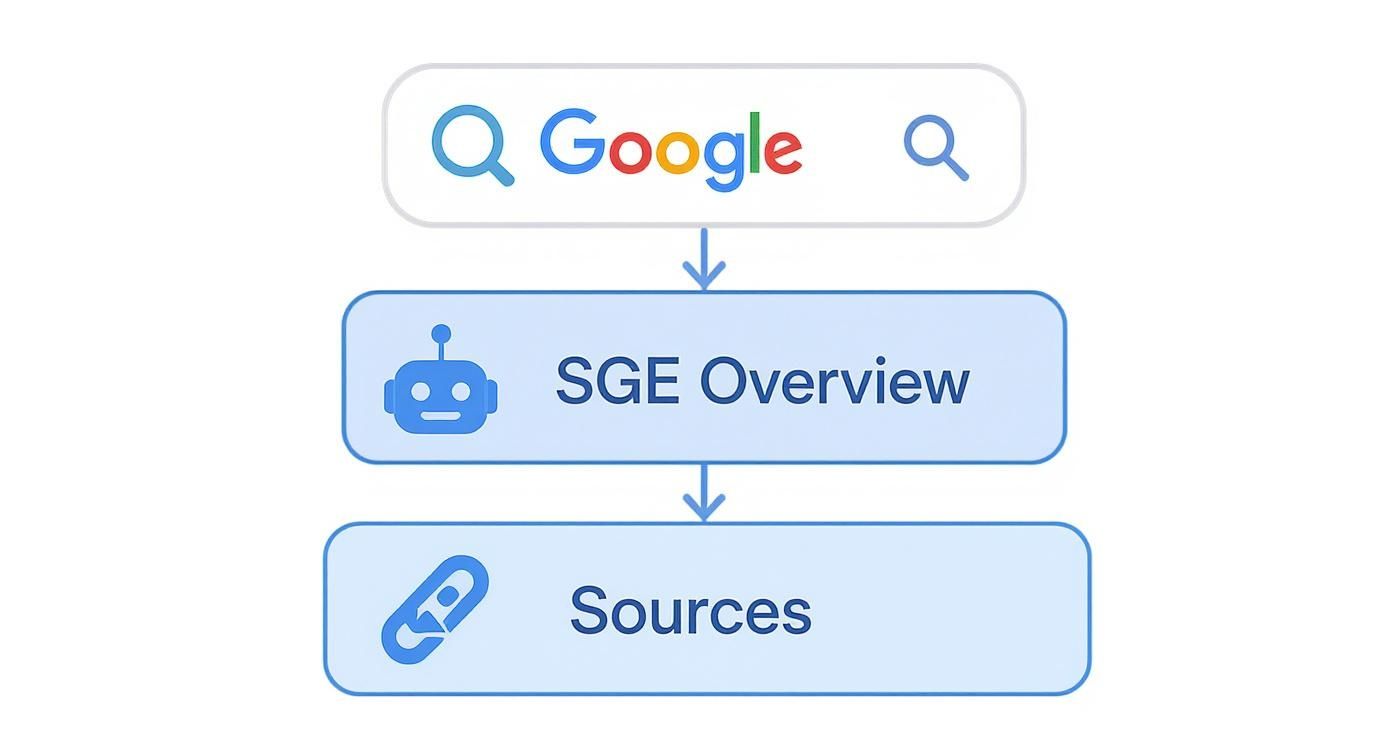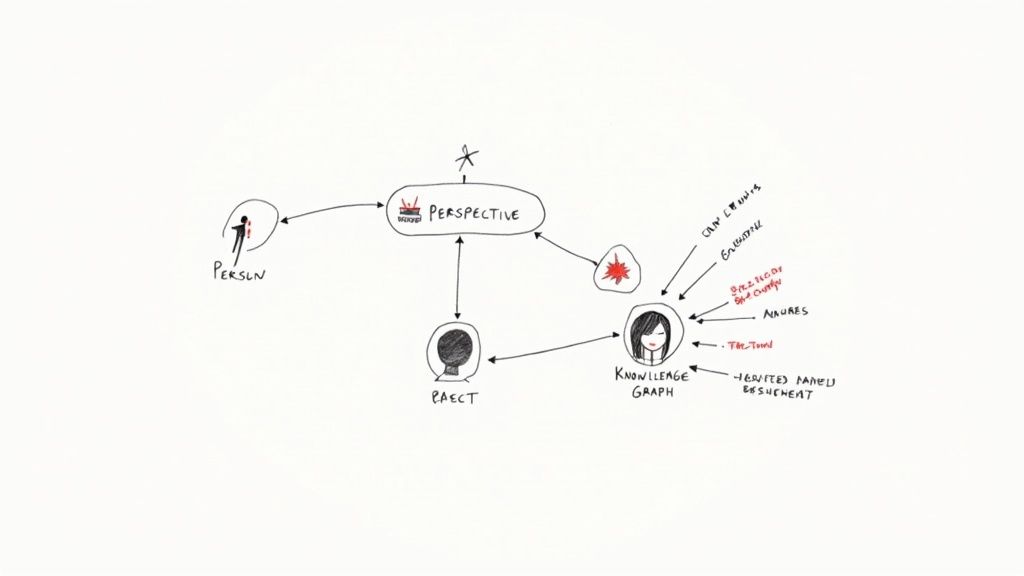Winning in Google's SGE isn't about keywords anymore. It’s about becoming the citable, authoritative source the AI relies on. This means you must build content with serious topical depth, structure it for machines, and inject unique, first-person insights that AI wants to reference.
The New Reality of SGE and AI Overviews
Google's Search Generative Experience (SGE) has flipped the script on search results. The classic "ten blue links" are being replaced by an interactive answer engine. This isn't a future trend—it's impacting your traffic right now.
The biggest change is the AI Overview, a summarized answer at the very top of results. When a user gets their answer from that AI-generated box, the motivation to scroll down and click on traditional organic links plummets. This is the new battlefield for SEO.
How AI Overviews Actually Work
Google's AI doesn't just skim the web. It synthesizes information from multiple sources it deems trustworthy to build a single, cohesive answer. It has a clear preference for content that is:
- Clearly Structured: Headings, lists, and tables make your content easy for the AI to parse.
- Factually Dense: Content packed with data, specific details, and direct answers wins over vague writing.
- Authoritative: The AI naturally gravitates toward sources that demonstrate deep expertise.
Getting cited in an AI Overview is the new #1 ranking. It’s not just having a link show up; it's having your content woven directly into the answer Google provides. This is a critical distinction for your site's future. To see where your brand stands today, it's worth checking your overall AI search visibility.
SGE is already showing up for a huge volume of queries. One study cited by seoprofy.com found that while sites featured in AI Overviews often overlap with top organic results, they can experience a significant traffic drop because users get their answer from the summary and never click through. This isn't a minor tweak; it's a fundamental change in how people use search.
Mini Case Study: A Tale of Two Blogs
Imagine two blogs fighting for the query, "how to choose a CRM for a small business."
- Blog A (Old SEO): Publishes a solid, 1,500-word article titled "Top 10 CRMs for Small Business in 2024." It ranks #3 organically. The problem? It uses long, narrative paragraphs to describe each CRM.
- Blog B (SGE-Optimized): Creates a content hub about "Small Business CRMs." Their main article uses H3s for each CRM, bullet points for key features, and a comparison table for pricing.
In the SGE world, Google's AI can instantly understand Blog B's structured content. It grabs the feature bullet points and pricing data for its AI Overview, citing Blog B as a key source.
Meanwhile, Blog A's long paragraphs are too much work for the AI to decode quickly, so it gets skipped. Blog B wins the valuable SGE citation and the attention that comes with it, even if its traditional ranking was slightly lower.
SGE rewards machine-readable clarity over classic long-form prose. The structure of your content is now as crucial as the information itself. Your job is to make it dead simple for the AI to understand, verify, and cite your expertise.
Build Topical Authority to Dominate SGE
In AI-driven search, topical authority is the currency that matters most. The days of chasing isolated keywords are over. To show up in Google SGE, your website must become the definitive, trusted source on a subject—not just a one-off answer to a single question.
Think of it like this: if you needed advice, would you trust the person who knows a little about everything, or the one who's a deep expert on your specific problem? Google's AI works on a similar wavelength.
You're not just trying to rank a single page anymore. You're proving your entire site's expertise.
Perform a Topical Gap Analysis
Before writing another word, you need to know where you stand. A topical gap analysis is your map, showing you exactly which subtopics your competitors cover that you don't. This is critical for SGE, since comprehensiveness is a massive signal of authority.
Start by picking 3-5 of your top competitors—the ones you see cited in SGE results. Use a tool like Ahrefs or Semrush to pull all the keywords their main content hubs or pillar pages rank for.
From that list, connect the dots:
- Group their keywords into sub-themes. Are they covering pricing, comparisons, use cases, or integrations?
- Compare these themes to your current content. Where are the obvious holes in your coverage?
- Prioritize the gaps you find. Zero in on subtopics that directly answer common follow-up questions. These are prime real estate for SGE.
This process replaces guesswork with a data-driven plan for building real authority.
Architect Your Content Hub
Once you know what's missing, you need a blueprint. A content hub is a strategically interlinked architecture built to signal deep expertise to search engines.
The go-to model is the pillar and cluster approach.
- Pillar Page: Your comprehensive guide covering the main topic from a high level (e.g., "The Ultimate Guide to Project Management Software").
- Cluster Content: Shorter, highly specific articles that dive deep into subtopics from your gap analysis (e.g., "Best PM Software for Remote Teams," "Trello vs. Asana Comparison," or "How to Calculate ROI on PM Tools").
This is the crucial part: Every cluster article must link back to the main pillar page. The pillar page, in turn, should link out to relevant cluster articles. This creates a powerful internal linking web that proves your topical knowledge to Google.
The infographic below shows how SGE pulls information from different sources to build its AI Overview.

This structure makes it incredibly easy for Google to see the hierarchy, extract key points, and synthesize your content into its overview.
A well-designed content hub does more than organize content for users. It creates a semantic map that algorithms can easily follow, proving your site's authority far more effectively than any single article ever could.
What worked for a list of ten blue links doesn't cut it for a single, AI-generated answer.
SGE Content Strategy: Old SEO vs. New
| Factor | Traditional SEO Approach | SGE Optimization Approach |
|---|---|---|
| Primary Goal | Rank a single page for a target keyword. | Become a cited source within the AI-generated answer. |
| Keyword Focus | Focus on a primary keyword and a few secondary terms per page. | Focus on broad topics and clusters of related user questions. |
| Content Depth | A 1,500-word article could rank well if optimized. | Comprehensive coverage is key; often requires 3,000+ words covering numerous subtopics. |
| Internal Linking | Link to relevant pages to pass authority. | Build a structured pillar-and-cluster model to demonstrate topical depth. |
| Structure | Standard blog post format (intro, body, conclusion). | Highly structured with clear headings (H2, H3), lists, and data points for easy AI parsing. |
| Success Metric | Achieving a top 3 position in organic search results. | Being featured prominently and repeatedly in SGE citations for a given topic. |
This table makes it clear: SGE demands a shift from page-level optimization to site-level authority. It's a more strategic game.
Mini Case Study: B2B SaaS Content Hub
A B2B SaaS company, "TeamTask," wants to own the topic "project management software for small teams."
- Gap Analysis: They check competitors like Asana and Trello. They spot that no one is covering niche subtopics like "PM software for creative agencies" or "integrating PM tools with Slack." These are their content gaps.
- Content Architecture:
- Pillar Page: They create a massive guide: "The Definitive Guide to Project Management for Small Teams."
- Cluster Content: They build articles to fill the gaps: "Top 5 PM Tools for Creative Agencies," "How to Sync Slack with Your PM Software," and "TeamTask vs. Trello: An Honest Comparison."
- Interlinking: Each cluster article links directly back to the main guide. The guide links out to the cluster articles when mentioning those subtopics.
This strategy is laser-focused on building strong Answer Engine Authority, which is the SGE equivalent of traditional domain authority. TeamTask now signals to Google that they are the go-to expert, making them a perfect candidate for SGE citations.
Structure Content for AI Consumption

Google’s AI doesn’t read your content like a person does. It's a machine that rips through your page looking for extractable facts, steps, and data points. This means your content’s structure is as important as the words themselves.
To show up in Google SGE, stop thinking like you're writing prose and start thinking like you're building a machine-readable database.
Poorly structured content is invisible to AI, no matter how well-written.
Build a Logical Information Hierarchy
Your content needs a relentlessly logical flow. Think of your H2s and H3s as an outline that tells a complete story on its own. The AI leans heavily on this heading structure to understand your main topics and sub-topics.
A solid grasp of what is information architecture is your secret weapon. It’s about organizing content so both humans and machines can find what they need, fast.
Instead of a generic H2 like "Key Features," get specific with something like "Key Features for Remote Team Collaboration." That extra context makes a world of difference to an AI.
Write in Declarative and Concise Sentences
AI models extract direct answers. Vague or flowery language creates ambiguity, making it harder for the machine to lock onto the core fact.
Write short, declarative sentences. Stick to one idea per sentence. For SGE optimization, this is non-negotiable.
Key Insight: Treat every paragraph as a potential snippet for an AI Overview. If a single paragraph can't be understood out of context, it's too complicated. The goal is to create quotable, self-contained blocks of information.
This is a huge departure from classic SEO. While deep content still matters, the individual pieces inside that content must be modular and easy to lift. This mindset is similar to what's needed for the future of AI answers, where clarity is king.
Use Lists and Tables to Present Data
Lists and tables are the native language of AI. They strip away fluff and present information in a perfectly structured format.
- Bulleted Lists: Perfect for highlighting features, benefits, or any items without a specific order.
- Numbered Lists: Use these exclusively for step-by-step instructions or processes.
- Tables: The ultimate tool for comparisons of products, pricing, or specs.
Mini Case Study: A B2B Software Review Site
A B2B software review site, "SaaSWorthy," was trying to get into SGE results for "best accounting software for freelancers."
- Before SGE Optimization: Their 2,000-word article was full of long paragraphs describing each software. It ranked #4 organically but was completely ignored by the AI Overview.
- After SGE Optimization: They reformatted the entire article without changing the core information.
- Each software product became its own H3.
- Key features for each product were converted into a bulleted list.
- They added a summary table at the top comparing pricing, free trial availability, and key integrations.
Within weeks, SaaSWorthy’s content was consistently pulled into the AI Overview. The AI grabbed their table to generate a comparison grid and lifted their bullet points to summarize features, citing them as a primary source. The structural change made all the difference.
Optimize for Entities and Unique Perspectives
To get ahead in SGE, stop thinking about just keywords and start focusing on entities and perspectives. Keywords are just words; entities are the real-world things, people, places, and concepts they represent. SGE understands these connections, not just text matches.
More critically, SGE actively hunts for unique, human perspectives to add authenticity to its answers. It frequently pulls quotes and firsthand experiences from forums, Reddit, and personal blogs. This is your single biggest opportunity to stand out from generic content and get cited.
Think in Concepts, Not Just Keywords
An entity is any well-defined concept Google can understand. The company "Apple" is one entity; the fruit "apple" is another. SGE leans on its Knowledge Graph—a massive database of entities and their relationships—to figure out the context behind any search.
When you write about "Paris," you're not just targeting a keyword. You should naturally weave in related entities like the "Eiffel Tower," "Louvre Museum," "River Seine," and "French cuisine." This signals a deeper, conceptual understanding that builds authority.
This screenshot gives you a glimpse into how Google's Knowledge Graph visually connects different entities.

This web of connections is how the AI "thinks," linking facts and ideas to create a richer answer.
How to Identify and Weave in Entities
Figuring out the right entities is easier than it sounds.
- Analyze SGE Overviews: Search for your main topic and look at the entities mentioned in the AI Overview. Google is showing you which concepts it believes are most important.
- Use Google's Own Features: Pay attention to the "People also ask" boxes and related search suggestions. These are goldmines for entity-rich subtopics.
- Explore Wikipedia: The table of contents and internal links on any relevant Wikipedia page can give you a roadmap of key entities to cover.
Once you have your list, weave them into your content naturally. This is a foundational part of any good SGE content strategy.
Key Takeaway: Your job is to create content that mirrors the structure of the Knowledge Graph. By connecting relevant entities, you make it easy for Google's AI to see your content as an authoritative source worthy of citation.
Inject Genuine Perspectives to Get Featured
This is where the real magic happens. SGE's "Perspectives" feature is designed to fight generic AI content by spotlighting real human experiences. It actively looks for quotes, opinions, and unique insights.
This is a massive signal from Google: first-person, experience-based content is now a ranking factor.
SGE wants to see that you've actually used the product, visited the place, or solved the problem. It's digging for details that only someone with real, hands-on experience would know. A great analysis on this subject can be found in this external guide on SGE optimization.
To bring this to life in your content:
- Use "I" and "we": Write from a first-person point of view. Share your personal story or your company's direct experience.
- Include original photos and videos: Stock photos are a dead giveaway. Show real images of your team using a product or your personal photos from a trip.
- Share specific, nuanced details: Don't just say a product is "easy to use." Talk about the specific onboarding step that impressed you or the counterintuitive feature you had to discover.
Mini Case Study: A Travel Blog Wins with Perspective
Imagine a travel blog trying to rank for "best solo travel destinations."
- The Competitor: A huge travel site publishes a generic listicle. It names "Paris" and "Tokyo" but offers zero real insight. It feels written by someone who has never traveled alone.
- The Winning Blog: A solo female traveler writes a deeply personal post. She doesn't just list cities; she shares her story.
- Entity Usage: She brings in specific entities: the "Chiang Mai Sunday Night Market" for its safety and the "Gion district" in Kyoto for its solo-friendly atmosphere.
- Perspective: She writes, "I felt safer walking through the Gion district at 10 PM than I do in my own hometown. The street food vendors were so friendly, and I never once felt out of place eating alone."
SGE is far more likely to pull her quote into its "Perspectives" section because it’s authentic, specific, and helpful. It answers the user’s real, underlying question: "Will I be safe and comfortable?" The competitor's generic list just can't compete.
A Practical Guide to Measuring SGE Performance
You can't improve what you don't measure. Traditional rank tracking is quickly becoming a vanity metric.
Seeing your site at position #3 means very little if an AI Overview answers the user's question, preventing most potential clicks. We need a new way to look at performance.
The focus must shift from a simple rank to your visibility inside the AI-generated answer. This means tracking citations, not just links.
Use Google Search Console to Find SGE Opportunities
Your best free starting point is Google Search Console (GSC). While it doesn't have a dedicated SGE report yet, you can read between the lines to find queries likely triggering AI Overviews.
Head to the Performance report. Filter for queries containing question-based keywords.
- How to...
- What is...
- Best...
- Compare...
Look for queries with high impressions but a suspiciously low click-through rate (CTR). This is often a sign an AI Overview is present and satisfying user intent on the SERP. A high-impression, low-CTR query is your SGE battleground.
Key Metrics That Matter for SGE
To get a handle on your performance, you need to track metrics that go beyond old-school SEO. The goal is to understand your "share of snapshot"—how often your content gets featured within the AI's answer.
Here are the new metrics to obsess over:
- Number of SGE Citations: The raw count of how many times your domain is listed as a source within AI Overviews.
- Citation Placement: Are you the first source cited or buried at the end? The primary citation carries the most perceived authority.
- Content Format Cited: Is the AI pulling your lists, tables, or a direct quote? Knowing this helps you replicate what works.
- SGE-Driven Traffic: Clicks coming directly from links inside an AI Overview. This requires a closer look at your referral data or specialized tools.
Monitoring your brand’s presence in these new formats is critical. We've adapted this approach for the AI search era in our guide on monitoring share of voice.
Example: A B2B Tech Blog
A B2B tech blog was targeting the query "how to migrate from Salesforce to HubSpot." They ranked at #2 and got steady traffic. Then, they noticed a 30% drop in clicks, even though their ranking never budged.
Using a third-party SGE tracking tool, they discovered the problem: a detailed AI Overview had appeared for that query. The overview cited their competitor three times, pulling a step-by-step list directly from their article. The blog? Not cited at all.
This was a wake-up call. The issue wasn't their ranking; it was their invisibility inside the SGE answer. That data prompted them to immediately reformat their own content with a clearer, step-by-step guide to win back those citations.
Your goal is no longer just to be on the page; it is to be the answer. If your performance reports don't reflect SGE visibility, you're flying blind.
Build a Monthly SGE Performance Review
You don’t need a complex system. A simple monthly check-in can make all the difference.
- Week 1: Identify Top Queries. Use GSC and a tool like AI SEO Tracker to pull your top 20-30 commercial-intent queries triggering SGE results.
- Week 2: Analyze Citations. Go through those queries and see which of your pages are cited. Who are your main competitors inside the SGE snapshot?
- Week 3: Review Content Gaps. Compare your pages against the competitor pages winning more citations. What are they doing that you aren't? Do they have a comparison table? A better-structured list?
- Week 4: Plan and Execute. Turn your findings into action items for the next month, from reformatting an article to adding a comparison table.
This framework shifts you from passively watching rankings to actively fighting for visibility where it now matters most.
Your Top SGE Questions, Answered
Jumping into SGE feels like the rules changed overnight. You have questions. Let's get straight to what you're asking.
Is Traditional SEO Dead Because of SGE?
No, but it’s different. The fundamentals—like creating genuinely helpful content and having a technically sound website—are more critical than ever. What's changed are the tactics.
Traditional SEO was about getting your page to rank. SGE optimization is about getting your content cited in the answer. This shifts the focus to structured data, topical authority, and writing in a way AI can easily understand. Your goal isn't just to snag the #1 blue link; it's to become a direct source for the AI Overview itself.
How Does Google Choose Which Sites to Cite in SGE?
Google looks for content that is authoritative, well-structured, and gives a direct answer. The algorithm scans for a few key signals to figure out which sources are reliable.
- Topical Depth: Websites that go deep on a subject with content hubs are seen as experts.
- Structured Content: Clear headings (H2s, H3s), lists, and tables make your content easy for AI to parse.
- Original Insights: First-hand experiences, unique data points, and quotes from experts often get featured in the "Perspectives" section.
At the end of the day, Google needs to trust that the information it's citing is clear, accurate, and verifiable.
The big idea is simple: make your content the most citable resource on the web for your topic. If your article is easier for an AI to digest and trust than your competitor's, you have a much better shot at being featured.
Can I Still Get Traffic if I'm Not in the AI Overview?
Yes, but it's getting tougher. The AI Overview owns the top of the search results. For many informational searches, people get what they need from the SGE snapshot and never scroll down to the organic listings.
While you can still get clicks from the classic blue links, that well is drying up for queries dominated by SGE. The most valuable clicks now come from source links embedded inside the AI Overview. Your primary goal must be earning those citations. If you're only focused on traditional rankings, you're fighting for a shrinking piece of the pie.
The only way to know if your content is ready for AI search is to see it through the eyes of an AI. AI SEO Tracker shows you exactly how models like ChatGPT, Gemini, and Claude interpret your pages. Our platform helps you spot content gaps, find high-intent questions, and gives you a clear action plan to earn more citations in AI answers.
See how your brand really shows up in AI-generated answers and start winning the queries that matter. Discover AI SEO Tracker today.

